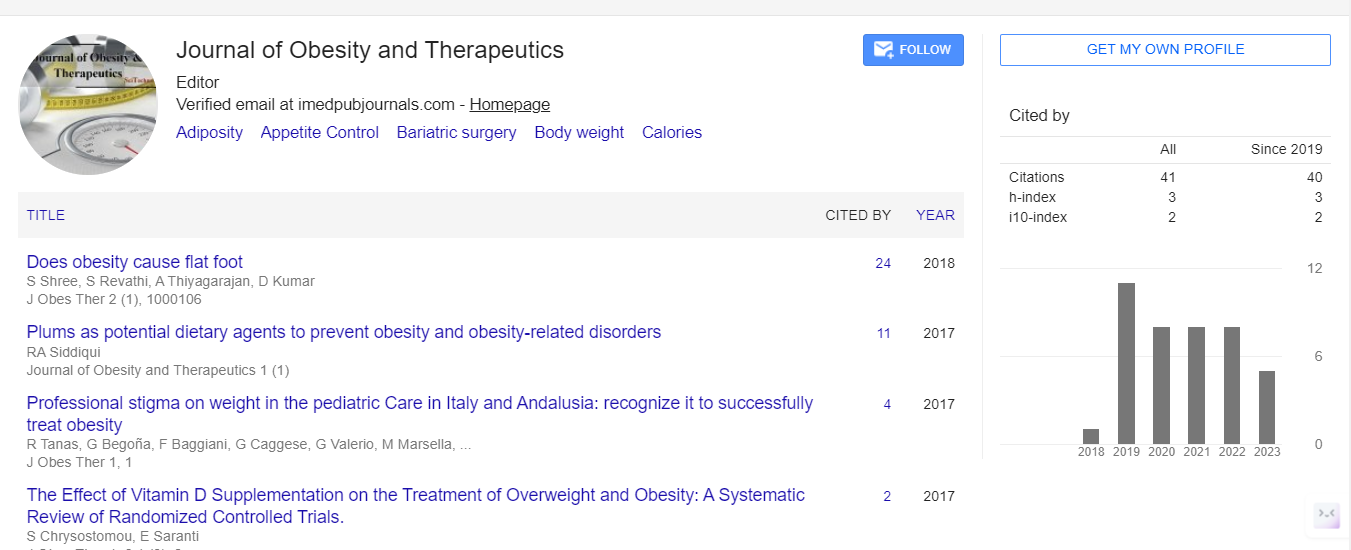Opinion Article, J Obes Ther Vol: 8 Issue: 4
Reducing Sugary Beverage Consumption: A Multi-Dimensional Approach to Curb Childhood Obesity through Policy and Education
Chloe Flabbert*
1Department of Pediatric Obesity and Nutrition, Johns Hopkins University, Baltimore, USA
*Corresponding Author: Chloe Flabbert,
Department of Pediatric Obesity and
Nutrition, Johns Hopkins University, Baltimore, USA
E-mail: linda.chubbs@outlook.com
Received date: 27 November, 2024, Manuscript No. JOT-24-159938;
Editor assigned date: 29 November, 2024, PreQC No. JOT-24-159938 (PQ);
Reviewed date: 13 December, 2024, QC No. JOT-24-159938;
Revised date: 20 December, 2024, Manuscript No. JOT-24-159938 (R);
Published date: 27 December, 2024, DOI: 10.4172/2324-9110.1000296.
Citation: Flabbert C (2024) Reducing Sugary Beverage Consumption: A Multi-Dimensional Approach to Curb Childhood Obesity through Policy and Education. J Obes Ther 8:4.
Abstract
Description
The Reducing sugary beverage consumption is a critical strategy in combating childhood obesity, a pressing global health issue that has seen increasing prevalence over the last four decades. The complexities of childhood obesity contain a countless of health complications, including cardio metabolic disorders, type 2 diabetes, hypertension, and dyslipidemia, along with psychological and social ramifications that can affect a child's quality of life and well-being. To address this multifaceted problem effectively, a multi-dimensional approach that incorporates robust policies and comprehensive educational strategies is essential.
One key component of reducing sugary beverage consumption is the implementation of public policies that directly target these products. Taxation on Sugar-Sweetened Beverages (SSBs) is one effective policy intervention that has garnered attention. Research has indicated that SSB taxation can lead to a significant reduction in consumption, thereby decreasing caloric intake and contributing to weight loss among children. Such taxes not only discourage the purchase of sugary drinks by making them less economically attractive, but they also generate revenue that can be allocated to health and nutrition programs aimed at reducing the impacts of childhood obesity. Moreover, policies limiting the marketing of sugary drinks to children plays an important role in shaping consumption behaviors. The American Academy of Pediatrics (AAP) and the American Heart Association (AHA) have advocated for stringent regulations surrounding advertising practices that target young audiences, as exposure to marketing has been shown to influence children's preferences and consumption patterns significantly. Regulations could include restrictions on advertisements during childfocused programming and the use of enticing packaging and promotional strategies that appeal to younger demographics. In addition to taxation and marketing restrictions, enhancing the food environment in schools is ultimate. Schools serve as critical settings where children learn about nutrition and make food choices. Implementing strict school food policies that promote the availability of healthier beverage options, such as water and milk, while limiting access to sugary drinks can foster positive dietary habits. Educational campaigns within schools can also equip children with the knowledge to make informed choices regarding their diets, emphasizing the importance of nutrition and the adverse health effects associated with excessive sugar consumption.
Education plays a complementary role in policy initiatives. Grassroots educational programs targeting children, families and communities can raise awareness about the health risks associated with SSBs. Community-based interventions can engage parents and caregivers, providing them with resources and strategies to encourage healthier beverage choices at home. Programs that teach children to read nutrition labels and understand the significance of added sugars are essential in promoting lifelong healthy eating habits. Public health campaigns can also utilize media and social platforms to disseminate important messages about the dangers of sugary drinks. By supporting a narrative that celebrates healthier choices and provides practical tips for reducing sugar intake, these campaigns can effectively shift public perceptions and behaviors over time.
Addressing the consumption of sugary beverages among children requires a coordinated approach that combines policy changes with educational efforts. Taxation, marketing regulations, healthier school environments, and comprehensive educational initiatives must work hand-in-hand to reduce the rising tide of childhood obesity. Through collective action from governments, health organizations, schools and communities, it is possible to create a healthier future for children, reducing the prevalence of obesity and its related health complications. This multi-dimensional strategy is not only essential for improving the health of children today but also for ensuring a healthier generation moving forward.
 Spanish
Spanish  Chinese
Chinese  Russian
Russian  German
German  French
French  Japanese
Japanese  Portuguese
Portuguese  Hindi
Hindi 